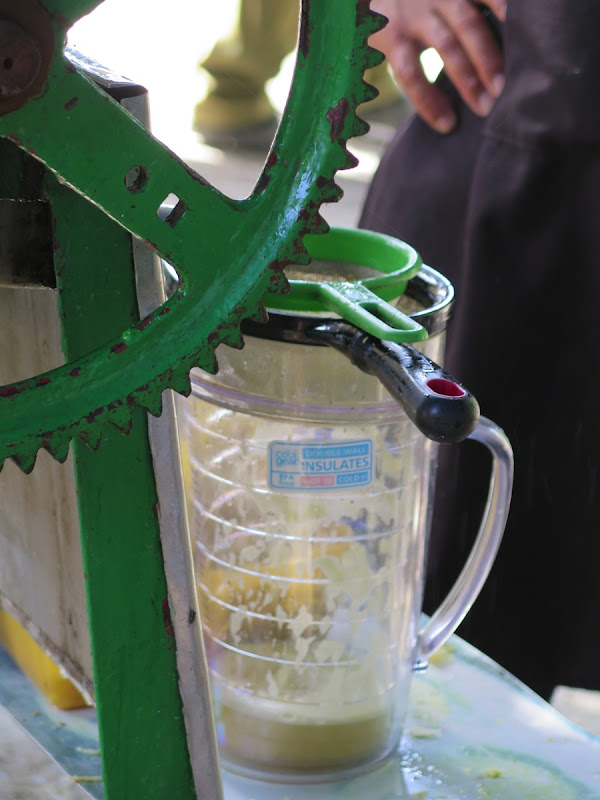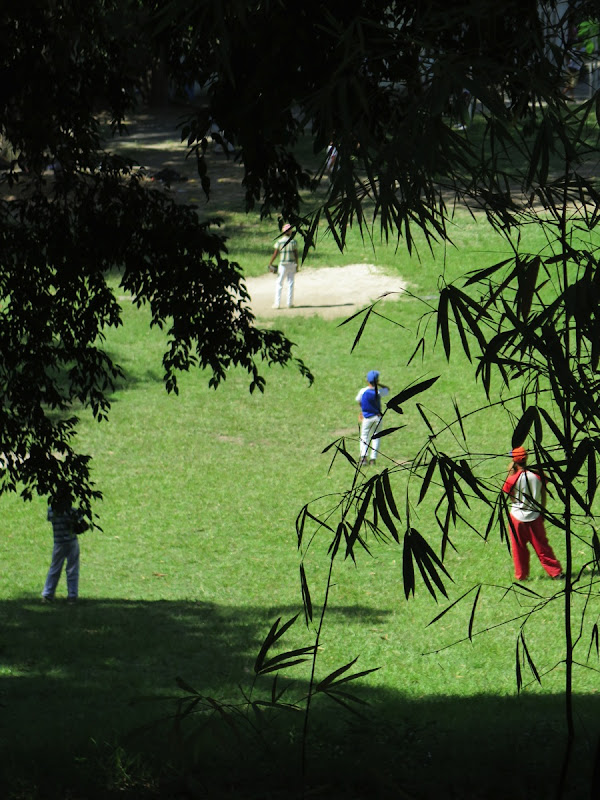 |
| One last look at the view from our window in Hotel Nacional. |
We checked out of Hotel Nacional to head for Varadero, our location for the next two nights.
 |
| Soviet-style apartments. I would judge these to be in decent repair relative to some other housing we saw. |
We passed out of Havana through an under the water tunnel-- one of the wonders of Cuba-- which connects Havana with the Alamar District, making it possible for people to commute to the city. The apartments we passed were block, Soviet style buildings. When the families were relocated there, they had to participate in building the apartments, so it was a little bit of a "Habitat for Humanity," style venture in the 1970's.
| Crops covered by screens to extend the growing season in the summer. |
Our first stop was an organic farm cooperative, and one of my favorite stops for the whole trip. The director of production gave us the tour. The cooperative is part of an urban agriculture movement; what we might call a CSA or community supported agriculture. Its mission had a lot in common with our local CSA, the Poughkeepsie Farm Project: To provide people in the community with better nutrition. In the 1990's, after the collapse of the Soviet Union, Cuba did not have access to chemical pesticides and fertilizer, so they began to grow almost everything organically, out of necessity. Since then, organic produce has taken off in many other countries, and Cuba's agriculture practices, born of necessity, are being studied by visitors from around the world. This cooperative is self financed, and pays the government 5% of its profits.They sell produce at the farm itself, as well as a small amount to paladars. We saw the ample fields of mint that help supply all those mojitos!
| Marketable mint for mojitos |
This cooperative has 800 square meters under cultivation, with 150-170 members. Having been in operation as an organic farm for so long, their experience is in demand, and "the government has been helping us," to connect to research centers. They make decisions democratically and elect a president every five years. They provide services to their workers: a barber, and a manicure/pedicurist (!), as well as special hours for mothers who work at the farm. People apply to work at the farm, and are given a three month trial before approval.
| Awesome worm composting beds |
| Motivational t-shirt worn by the production manager |
We departed the farm, gifting some small over-the-counter medical supplies to the production manager for the workers, and headed to Ernest Hemingway's Cuba house.
| View of living room from front door |
I was surprised to learn the Hemingway has long been beloved by the Cuban people. He is called "Papa" there, and every student reads at least one Hemingway in school. Although he lived (and drank) in Havana for years (his bar: The Flordita, where the daiquiri was invented), his third wife, Martha Gelhorne, persuaded her husband to move to the country "for quiet." He purchased (1940) and lived at Finca Vigia in San Fransisco de Paula, about ten miles out of Havana.
He wrote For Whom the Bells Tolls, The Old Man and the Sea, and A Moveable Feast, while he lived in Cuba.
| After you've imagined water in the pool, add an au natural Ava Gardner-- she was there too. |
The home is lovely, and you view the home by looking through the windows from the outside. That sounds crazy, and it does feel a little illicit, but, the windows do afford a good view, at least.
The most obvious: It is a home full of books (9,000), some bullfighting posters and other art, and his hunting trophies. The most famous is his African kudu, which Mussolini is fabled to have sent Hemingway a blank check in order to buy it. Hemingway is said to have written back something like, "Shoot your own," or "I don't hunt for a living," in response.
 |
| Coveted kudu |
An eccentricity is that he kept a record of his weight written on the wall in his bathroom. Wonder what Papa might have done with a fitness app on an iphone?

We drank a sugar cane juice refresher (or cocktail) while we were at the house and it was fresh squeezed in this very interesting machine:

The Hemingway House is the only place in Cuba that we saw baseball-- perhaps because it is so hot-- and this little league team may have been for the benefit of tour groups. Nevertheless, it is a heartwarming tradition because Hemingway sponsors a local boys team, importing equipment for them, and gave them rights to play on his estate grounds, where the game seems to go on.

The Old Man and the Sea is set in the fishing village of Cojimar. We stopped by a fort still in use, and had lunch at a paladar. This is also the location of the "Hemingway Marlin Tournament," which Hemingway won and was awarded his trophy by Fidel, the only time the two ever met.
| 1649 and still in use as a garrison |
Our last cultural attraction for the day was in Matanzas, a small town that was the birthplace of the Cuban rhumba. Our stop was Callejon de las Tradiciones, which was a community project to educate visitors about Cuba's history with the slave trade. Street performers danced and drummed for us, got us to dance, and one of us to play the drums. There was a ceba tree altar, and it is known as Little Africa of the Caribbean; a melting pot of a mixture of tribes.

In all, it was my least favorite stop, perhaps because it was very hot and I didn't feel worthy of having people work up a sweat dancing for me.
And then we arrived at the posh Hotel Melia Varadero, an all inclusive resort on one of the world's most beautiful beaches.
No comments:
Post a Comment